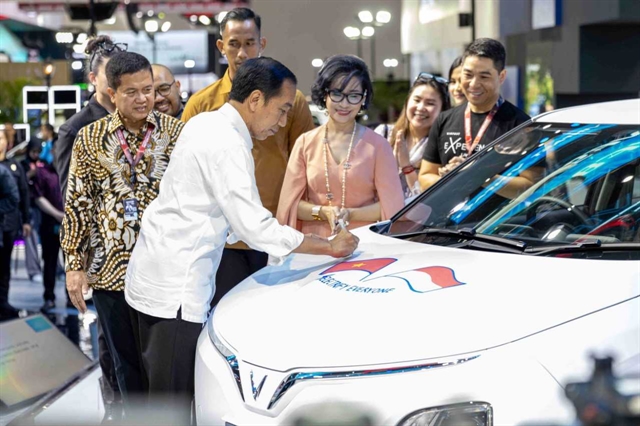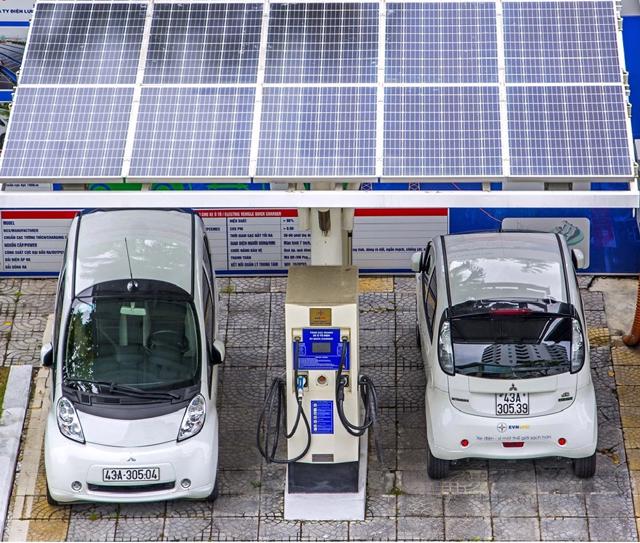 Economy
Economy

 |
| A grid-tied rooftop solar system at an EV charging station. The country’s first electric vehicle (EV) parking/EV charging station was put into operation in Đà Nẵng city in 2017. — Photo courtesy of vneconomy.vn |
HÀ NỘI — Việt Nam’s electric vehicle (EV) market will undergo changes in the coming years as the need to transition from internal combustion engine vehicles to electric vehicles increases. However, this transition may face challenges related to technical infrastructure and increasing electricity prices in the country.
Việt Nam has been experiencing a steady increase in average retail electricity prices over the past 15 years, typically adjusted once a year, with occasional biennial increases. The annual increase in retail electricity prices has ranged from approximately 4.5 per cent to 8.5 per cent. These increases affect various sectors, including production, business, daily life and services that rely on grid electricity, such as electric vehicle charging stations.
Currently, the Vietnamese Government sets the average retail electricity price at VNĐ2,006.79/kWh (excluding VAT). The retail price of electricity for charging stations is calculated based on the retail price of business electricity. For voltage levels below 6 kV, the normal hour rate is VNĐ2,870/kWh, the off-peak hour rate is VNĐ1,746/kWh, and the peak hour rate is VNĐ4,937/kWh. These prices are applied to businesses engaged in commercial activities that require electricity. There no specific regulations regarding a price ceiling that businesses must adhere to.
In scenarios of increasing electricity prices, consumers may face disadvantages. Higher electricity bills can directly impact household budgets, especially for those with limited incomes. The increased electricity costs can indirectly affect the prices of other goods and services. For example, businesses that rely on electricity for production and transportation may pass on their increased costs to consumers, leading to higher prices for goods and services.
The reliance on imports to supplement electricity supply during peak periods is not uncommon in many countries, especially when there is a sudden increase in electricity consumption due to factors like hot weather and increased use of cooling systems. Importing electricity can help meet short-term demand fluctuations and ensure a stable electricity supply.
Some experts said that promoting the development of renewable energy sources and encouraging their use in charging station systems can contribute to ensuring energy security in the context of increasing numbers of battery electric vehicles (BEVs) and plug-in hybrid electric vehicles (PHEVs) in urban areas.
However, it will take many years to establish a system of third-party charging station service businesses in Việt Nam.
Việt Nam's electric car market may not be as large as some other countries at the moment, but it is important to consider the potential for future growth. When the EV market accounts for 10 per cent of the total number of new cars, this will help stimulate the development of charging station services.
Vietnam Automotive Manufacturing Association (VAMA) reports that VinFast's global EV sales in 2023 reached 34,855 units or 11.5 per cent of their market share. However, VinFast being proactive in its charging station system implies that they have developed a robust infrastructure to support their EVs.
Việt Nam’s EV market is facing a lack of technology. It is noted that the dependence on imported chargers and the need for technology localisation are common challenges for developing charging infrastructure. Collaborative efforts between international companies, Vietnamese engineers, and research institutions can help address these technology gaps and facilitate the adoption of renewable energy solutions for charging stations.
Investment capital is also crucial for establishing charging infrastructure and developing a "green" energy ecosystem. While it may be challenging to attract significant investment in the early stages, as the market grows and the demand for charging stations increases, it can attract the attention of potential investors in charging infrastructure development.
Opportunity for hybrid cars
Hybrid cars offer certain advantages in the context of insufficient charging stations and high electricity prices. In addition, as gasoline prices rise and shortage occur, there has been an increasing interest in EVs as alternative means of “green” transportation.
In addition, as gasoline prices continue to increase, accompanied by local shortages of gasoline and oil, many people have been urged to switch to electric vehicles with the desire to use "green" means of transportation and save fuel effectively.
Furthermore, charging time for EVs typically take longer to charge compared to refuelling a gasoline vehicle. It takes about 6-8 hours to fully charge a battery with a range of between 300-400km.
Hybrid cars provide a significant opportunity to address the challenges associated with conventional gasoline-powered vehicles. By combining an internal combustion engine with an electric propulsion system, hybrid cars offer improved fuel efficiency and reduced emissions compared to traditional gasoline cars.
Research conducted by the Hanoi University of Science and Technology, suggesting that hybrid cars consume approximately 50 per cent less fuel for internal combustion, highlights the potential benefits of this technology. This improved efficiency can contribute to a reduction in greenhouse gas emissions and decreased dependence on fossil fuels.
In Việt Nam, several automobile manufacturers, such as Toyota, Nissan, Suzuki and Haval, offer hybrid models with a price difference of around VNĐ100 million (US$4,166) compared to their gasoline counterparts. These hybrid models generally do not require significant changes in driving habits compared to fully electric vehicles, making them more accessible to consumers who may be hesitant to transition to purely electric vehicles. — VNS




